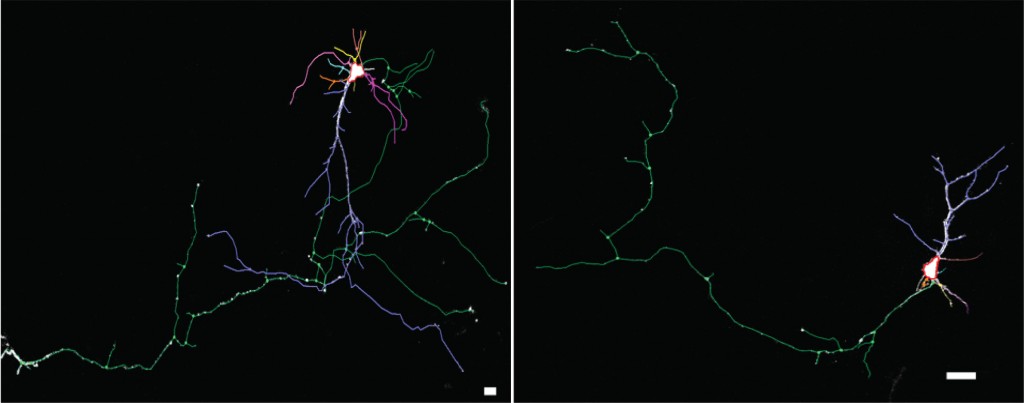
Researchers Restore Neuron Branching in Model of Mutant NHE6 Gene

Mice with the NHE6 gene mutation show less dendritic branching. Using Neurolucida, researchers traced a GFP-labeled neuron reconstructed with confocal z stacks in a wild type mouse (left) and a mouse with a mutant NHE6 gene (right). Image courtesy of first author Qing Ouyang, PhD, Alpert Medical School, Brown University.
Children with the neurogenetic disorder Christianson Syndrome experience delays in language and learning; they may also have seizures, and display symptoms of autism. Scientists say these disorders are a result of stunted brain cell growth, which occurs because of a mutation in the gene that produces the protein NHE6—a protein also mutant in several forms of autism.
Neurons in human brains with the mutant gene don’t branch as robustly or form connections as well as neurons in normal brains. But researchers at Brown University may have found a way to restore the ability of these cells to grow properly.
In their study, published in the journal Neuron, senior author Dr. Eric Morrow and his team describe a signaling pathway for neuronal growth involving NHE6. Using a mouse model with an NHE6 gene mutation, they found that reduced levels of NHE6 combined with increased acidity in a cell’s endosome, results in a depletion of the receptor protein TrkB, a key player in the growth and branching of axons and dendrites.
To instigate branching, TrkB binds with another protein, BDNF. Hypothesizing that increased levels of BDNF would enhance TrkB signaling and rescue branching, the scientists directly injected the protein into cells. Using Neurolucida to trace wild type and mutant neurons treated with BDNF, they found branching of axons and dendrites in mutant cells increased to a level “approaching wild type levels.”
Specifically, the paper reports an increase in axonal branching from 16.7 branch points per cell to 27.7; dendritic branching increased from 20.3 branches per cell to 34.4; and primary dendrites increased from an average of 6.5 to 8.7.
“In this paper we show that BDNF signaling is attenuated in the mutant mice, but it’s not blocked,” Dr. Morrow told Brown University in a press release. “You can rescue the [neuronal growth] by turning up the signaling.”
Ouyang, Q., Lizarraga, SB., Schmidt, M., Yang, U., Gong, J., Ellisor, D., Kauer, JA, Morrow, EM. (2013). Christianson Syndrome Protein NHE6 Modulates TrkB Endosomal Signaling Required for Neuronal Circuit Development. Neuron. 2013 Oct 2;80(1):97-112. doi: 10.1016/j.neuron.2013.07.043


